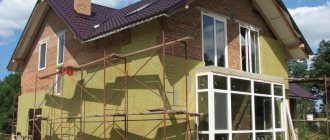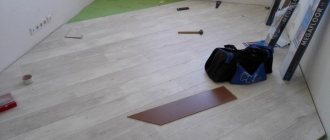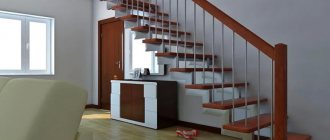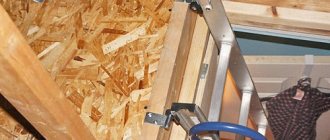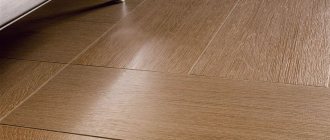First of all, you need to install two grips near each joint of the steps. Their length should be 5 centimeters shorter than the width of the steps (since the grips are nailed along the width).
The grips are attached with nails to the riser (the surface of the step is perpendicular to the floor) at a distance from the tread (the surface of the step is parallel to the floor) equal to the height of the two grips connected together with needles facing each other. The grip that is attached to the tread should be located at a distance of 15 mm from the riser.
Lining flooring
The lining must be cut wide to fit the grips. The lining is attached from the grip of the tread to the bend across the step, where after the bend its length should be 75 mm on the riser.
If the staircase ends with a railing at one edge, then from this edge it is necessary to cut off the corner, gasket, which is located on the riser from the side of the railing. You need to cut from the bend.
Care Tips
Carpets must be vacuumed thoroughly. If treatment with cleaning agents is required, the mats are first removed from the steps. Rubber, plastic and aluminum panels are periodically wiped with a damp cloth to remove dust and dirt. Although it is recommended to remove such step pads from time to time from the stairs and wash them under running water. Solvents must not be used. Proper care and timely gentle cleaning will help maintain the original appearance and extend the service life of protective staircase elements.
Preparing carpet for laying
If the stairs are open, the carpet should be folded along the long edge, at a distance of 25 mm on each side. First, mark the fold with something writing (chalk, for example), and then, using a non-sharp thin object, drawing along the marked line, bend the edge of the carpet. Do not secure the folded edge!
If the staircase is closed, then the carpet can only be adjusted to the size of the steps, and the cut can be secured with special glue or mastic.
General information
Overlays - what are they for?
A staircase is a full-fledged element of the interior or exterior of a building, and therefore its appearance requires the closest attention. However, in most cases, stairs are made before all finishing work is completed, and therefore stand out somewhat from the overall design of the room.
To avoid this and ensure the most harmonious picture, many either cover the steps with carpets or lay special overlays.
The use of carpet makes it possible to “fit” the staircase into the interior
However, in addition to the aesthetic function, overhead elements also perform a number of others:
- First, they mask wear on the treads, especially in those parts that suffer the most from friction and stress.
- Overlays made of dense materials protect surfaces from damage. This function becomes most relevant if the staircase is made of expensive wood or decorative stone.
- To minimize the risk of injury, special anti-slip mats are often installed on external stairs. The same devices are also used to equip passages in public buildings with high traffic.
In offices without such a design, stairs would have to be repaired very often
- Well, for the northern regions, special heating mats that prevent icing will be relevant.
Classification
As you can see, although simple, step pads can be very useful. If you are thinking about purchasing such devices, you should first familiarize yourself with the entire available range.
Most manufacturers produce the following types of products:
- Decorative (made from carpet or similar materials).
- Bamboo (combines a protective function with giving the steps an attractive appearance).
- Protective (most often they have an angular design, preventing damage to the edge or plane of the steps).
- Anti-slip pads for stairs (made of rubber, can be mounted on a metal frame).
Tape anti-slip profile
- Warming.
A separate category consists of overhead steps for stairs, which can be made of either wood or artificial stone. They are a set of panels that fit onto an old staircase and give it a completely new look.
Artificial granite structure
Below we will look in detail at the most popular varieties, and also describe how you can install them yourself.
Final fixation of the carpet on the bottom step
Pull the carpet onto the bottom step by placing it over the tread grip, while simultaneously pushing part of the carpet into the joint between the bottom and next step grips.
It is convenient to read the tension about the center, avoid distortions. Angle the tensioner away from the center.
Features of self-installation of anti-slip pads
There is nothing complicated in organizing anti-slip protection, but for self-installation it is better to use local self-adhesive coatings. The main difficulties in installing such elements will only be to ensure high-quality cleaning and marking of the surface.
All that is required is to separate the protective layer from the product, fix it according to the marking lines and roll it with a rubber roller or tap it with a mallet for better adhesion.
The main thing is accuracy, because re-installation is impossible.
Adjusting the edges of the carpet
If a slight distortion could not be avoided or the steps are slightly different in size, a folded edge will help. Use an awl with a long, strong needle to change the size of the hem, narrowing or widening the carpet.
After adjusting the edges, you can secure them with furniture nails and hammer them into the joint (corner) between the steps.
How to correctly calculate the amount of carpet
Starting at the very top, determine the length of all risers and treads using a tape measure, add 4 cm to the size of each step, then add up all the numbers.
If you are going to sheath a turning staircase, use the outside edge to measure. To determine the width, measure the widest step at the turn.
For an open staircase, add an additional 4 cm to the width of the steps to roll up the covering.
IMPORTANT: The flight of stairs must be covered with carpet from the top landing to the bottom riser.
What tools and additional materials will be needed for the work:
- On glue.
- On duct tape.
- With carpet holders.
- On wooden planks
Stretching the carpet onto the remaining steps
By analogy with the bottom step, pull the carpet over the rest, secure the carpet in the gap between the step grips, starting with stretching it onto the tread.
If you need a long path of two panels, their stick should be designed like this.
Fasten the end of one panel to the tread, cutting off the excess if necessary, and fasten the next panel from the end of the previous one to the grip of the tread, and pull it onto the step as you pulled the beginning of the path onto the bottom one.
Not only traditions
A staircase trimmed with solid wood is associated with a natural, incomparable interior. Warmth and comfort are the main advantages of wood. In addition, the material has the following qualities:
When cladding stairs, many people prefer wood, its texture and natural beauty. A metal or concrete staircase structure acquires its own individuality. A rich palette of colors, the possibility of painting and tinting make wood a leader among finishing materials used for cladding stairs.
Carpet selection
First of all, you need to worry about purchasing materials, primarily carpet. It must be wear-resistant with a high pile density. Since a low-quality carpet on the stairs will quickly become unusable. Jacquard or carpets with a textile base are suitable.
It is also necessary to put a middle layer under the carpet, a pad that will separate the wooden steps from the carpet. Choosing “foam” as a gasket would not be the best solution, but it is recommended to pay attention to a rubber one with a corrugated, waffle or felt surface.
Double-sided adhesive tape
Fastening the carpet on the stairs is possible using a special adhesive tape coated with an adhesive substance on both sides. Typically, the base is a strip of fabric (mostly cotton), on both sides of which rubber-based adhesive is applied.
The great advantage of using this material is its ease of use.
Installation can be done independently, but all operations should be carried out in stages:
- the required coverage is selected;
- the carpet is leveled (during the day it is in an unbent position);
- tape is applied to the surface (first along the perimeter, then in the form of a grid with cell sizes of 50x50 cm, or based on the design parameters);
- The track is laid, after which it is pressed at the points of contact with the adhesive tape.
This method of fixation can be used at temperatures from -20 to +50 degrees. Excellent for all types of surfaces, including those with uneven surfaces.
Some coating options already include double-sided adhesive tape. This makes the fastening process easier.
Rugs with self-adhesive elements provided:
Attaching the mat to the stairs
Reliable installation of carpets on stairs is possible with the help of fixing slats. This is a rather labor-intensive process that requires the use of additional materials, but it guarantees reliable fixation. The work is carried out in several stages:
- along the back of the tread, a strip with spikes is laid (driven in with nails pointing upward); for greater reliability, the strip can be positioned in the form of a corner between the tread and the riser;
- before laying the carpet, the stairs are covered with a felt layer;
- the track is pulled with maximum force over the felt;
- the carpet is pulled into the gap formed between the slats using a chisel;
- in the places of the slats, you need to tap with a chisel or gentle blows of a mallet (this will ensure reliable fixation);
- at the point of contact with the wall, trimming is carried out along the bend line;
- at the end, the material is fixed with two rows of spikes, which are covered with a metal strip.
Using this option is less gentle than the previous two, but guarantees reliable fixation.
Each of the presented options has its own disadvantages and advantages, and their use must be chosen based on a number of features:
- staircase design features;
- degree of load on the surface and stairs (intensity of pedestrian traffic, carried loads);
- temperature conditions;
- design ideas;
- the prospect of using uncoated stairs (in the future);
- the ability and desire to carry out work independently (or with the help of employees with the necessary experience).
By correctly selecting all the necessary parameters, you can achieve maximum fastening efficiency. Using each of the presented options allows you to maintain a fairly good appearance of the staircase, which will allow it to look beautiful even if the carpet is removed.
You can fix the carpet on the stairs using these methods without having any special construction skills. It is enough to familiarize yourself with the procedure for carrying out the work, select the required tools and you can begin to carry out the work.
Video: securing carpet using a holder:
Other articles
- The height of the railing (fence) on the stairs according to GOST in Belarus
- Hot forging
When arranging the interior space of the house, you should take care of the safety of movement on stairs, especially if children or elderly relatives will live here.
Estimating the size of the carpet
The width of the carpet is measured both as a whole and separately for each step. It is worth adding 50 mm to the width for bends.
The length of the carpet is measured by a thread that must be laid along the entire profile of the stairs, adding 25 mm to the length for each step. This is necessary due to the width of the carpet and padding materials.
The staircase in the house is not only a necessary element from a practical point of view, but also an important part of the decor. A staircase with dirty railings and worn steps can ruin the look of any interior. And freshly painted carved pillars, on the contrary, will make the look special.
The article described how to cover steps with carpet. Which is certainly a classic, and classic solutions will always look beautiful. In addition, when the carpet wears out on the steps, it is much easier to replace it than boards.
Carpet calculation
- Measurement starts from the top, and all treads and risers are summed up. It is recommended to add 4 cm to each step.
- Screws are measured along the outer edge. The width of the covering should correspond to the widest step at the turn.
- If the stairs are open on one side, add another 4 cm to the width of the covering at its hem.
To calculate the material, use the following method, which works even in the most difficult cases.
Take measurements from the largest step and multiply the resulting value by their total number. Such a calculation already includes allowances for waste that may be generated when cutting carpet.
Laying methods
Solid steps look much more beautiful, however, they are more difficult to lay.
The cutting of product elements is carried out for each step separately. The work is greatly simplified by using templates. It is cut out along the fold lines from thick paper. In this case, the cutting will be more accurate and the need for adjustment will be reduced.
The flooring is laid by smoothly connecting the elements to each other. The most convenient joining of carpet is on adhesive canvas. This method allows you to quickly replace the old coating with a new one. You can connect one part to another using glue or fixing strips that have jagged edges.
Technology for laying carpet on stairs using fixing strips
If necessary, the steps are pre-repaired and painted. Then, in the corners between the risers and treads, strips are nailed to fix the covering, directing the nails towards the corners. This can be a special L-shaped clamp or two ordinary strips, each of which should be 12 mm from the corner.
The planks for the platform are cut to length with a special hacksaw - a reward and fixed in the same way as laying the covering indoors. Before proceeding directly to laying the carpet, the fixing strips for the stairs must be completely installed.
The backing is cut out according to the width of the carpet and the length of the narrow section with an allowance for the length of 25 mm. The material is placed on the upper tread, and it should fall through the roller. Then they secure it on three sides, the back and side edges, with nails or staples. Do the same with all treads.
The carpet from the upper platform is cut with a carpet knife. The top of the riser should remain covered. Place the material on the fixing bar and cut off the excess.
Align the edges of the material on the bottom step and the top tread, then place its end on the teeth of the clamp and secure it using a scarpel and a mallet. This process looks like this in more detail: starting from one corner, using a scarpel, the material is placed on the teeth of the strip, gradually moving in the opposite direction. For better fixation, tap the scarpel with a rubber mallet. During the fastening process, the canvas is unrolled at the next stage.
The carpet must be leveled at each step. If necessary, the roll is moved. When completing the span, excess covering is cut off. Excess pieces are also cut off on the upper step.
Overlays for steps
There is a trick that will help the flooring wear out more evenly: at the top step, wrap about a meter of material underneath, and after a year, release the tension from the raw material and move it slightly, having first unrolled it.
Photo of carpet on stairs
Materials
Manufacturers most often use brass, stainless steel and aluminum. All of the listed metals are durable and can not change their appearance for a long time in the conditions of an ordinary heated room, where the product is not exposed to moisture, aggressive chemicals, ultra-high temperatures and other unfavorable factors.
Brass is a non-ferrous metal, an alloy based on copper. Products made from it are very beautiful and have a pleasant golden color. This barbell will look great on the red carpet.
Anodized aluminum has a bluish color. It looks quite simple, like stainless steel, and is inexpensive. Elements made from it can be used in interiors of almost any style. The accessory will not stand out and will be almost invisible. If you want the holder to go unnoticed, this is a great option for you.
Review of the advantages of rope structures
Comparing with analogues, we can highlight a number of significant advantages, thanks to which the task of maintaining a well is simplified:
- Mobility, due to the low weight of the materials used in manufacturing. This allows you to transport the ladder to any distance without the need to involve assistants.
- Compact dimensions, which opens up wide possibilities for storing the product.
- The ladder can be easily adjusted in length, so it can be used to service wells of any depth.
- The affordable cost of materials allows you to avoid large expenses.
- Easy to install, since a DIY rope ladder does not require special knowledge to implement such a solution.
- Possibility of use for absolutely any task of organizing descent.
Such a design can be used even in situations where it would seem problematic to descend to a certain depth.
